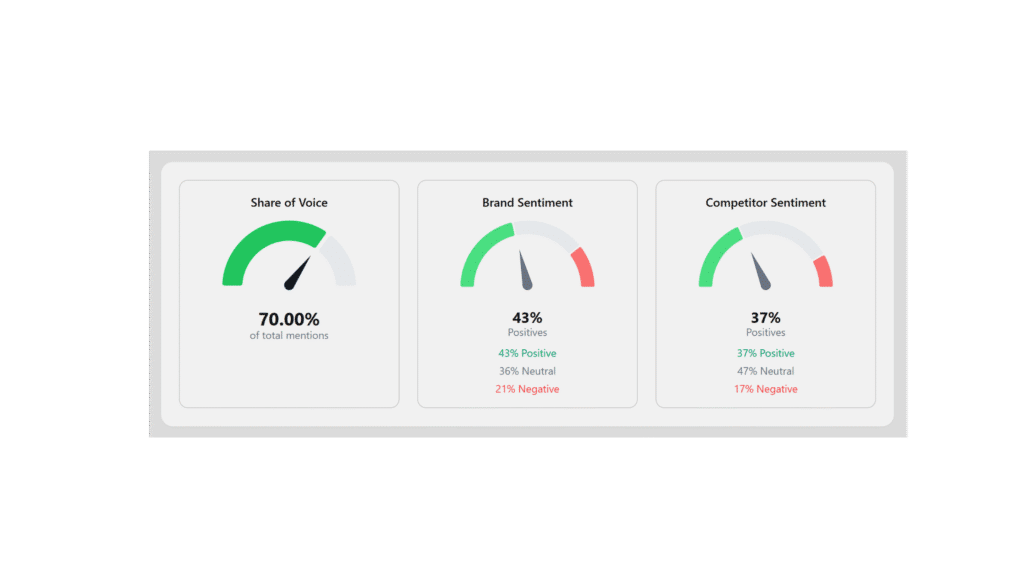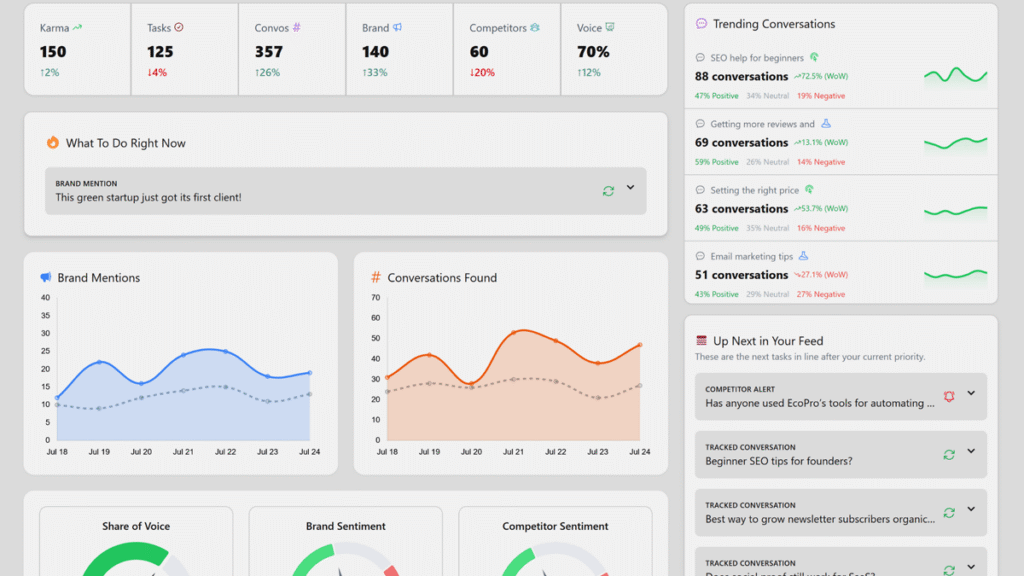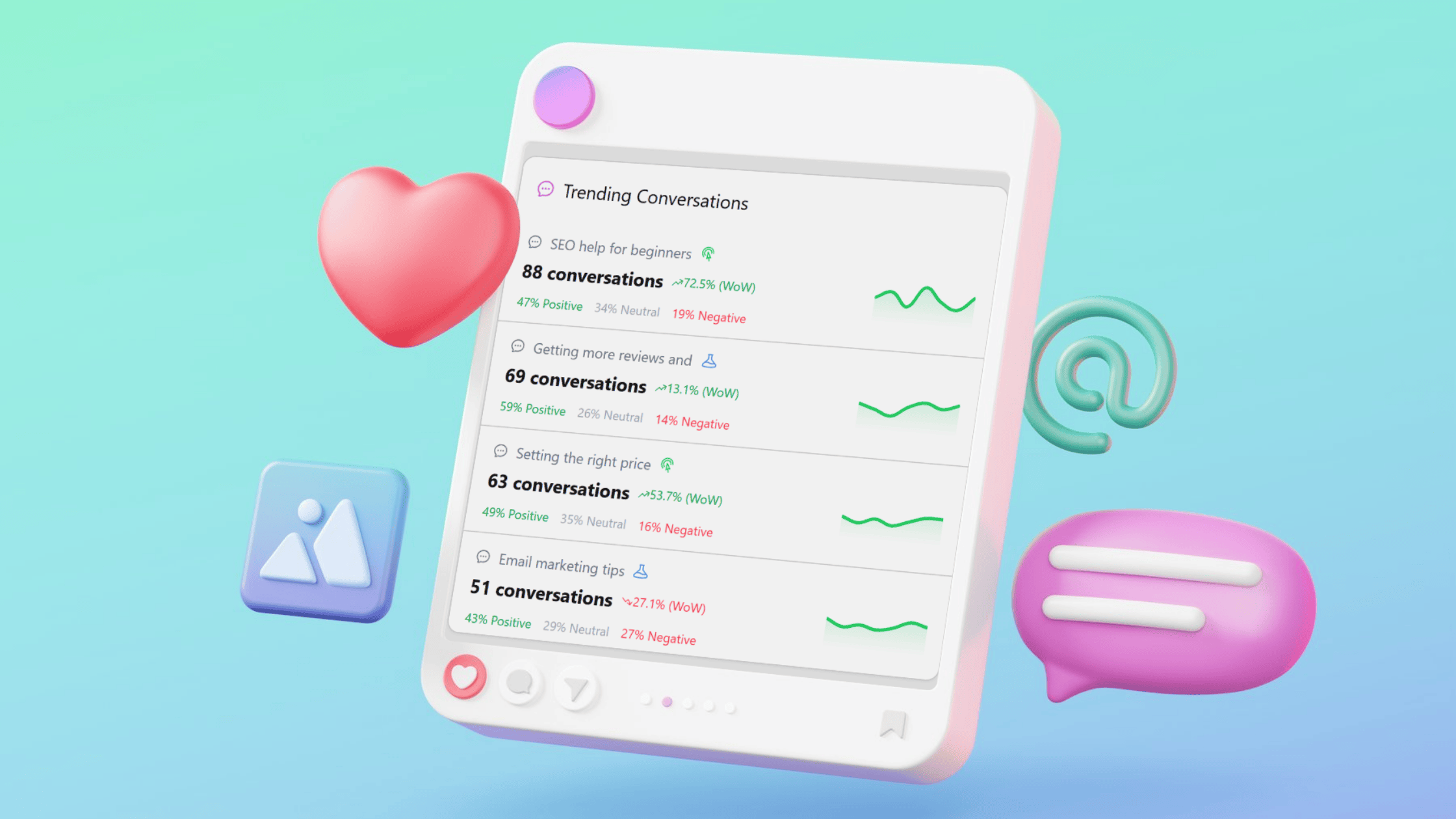If your customers are talking about you online, you should be listening. And it’s not just about volume. You need to listen for tone, context, and opportunities. That’s where social media sentiment analysis comes in.
This guide seeks to answer what social media sentiment analysis does, how it works, why it matters, and (maybe most importantly) how to get the biggest ROI when using it.
What Is Social Media Sentiment Analysis?
Social media sentiment analysis is the process of using natural language processing (NLP) and machine learning to determine whether the conversations surrounding a brand, topic, or campaign are positive, negative, or neutral. It counts engagement and mentions, sure, but it also interprets meaning.
That analysis is the key for teams working in marketing, product, and sales. It provides valuable insight into the mind of the customer (and potential customer). And it’s much, much more powerful than just sending out a survey to your existing user base.
Why It Matters for Marketing Leaders
From a marketing executive’s perspective, sentiment analysis is a live feed of consumer perception, brand health, and campaign impact. It’s not just social listening. Yes, it easily tracks brand mentions, sure. But it also tracks how people feel about specific topics in your industry.
Here’s why it’s indispensable:
1. It Gives You the Why Behind the Metrics
A spike in brand mentions is meaningless without context. Sentiment analysis reveals whether those mentions stem from a rave review or a PR crisis. When sentiment analysis is done well, it also tracks topics beyond brand mentions (and competitor mentions).

AI tools like Karmatic understand the problems you solve and the communities you serve. It tracks conversations in these communities to highlight exactly what people want and why.
2. It Protects Brand Reputation and Customer Experience
Negative sentiment can spread fast. With real-time sentiment alerts, your team can detect issues early, respond strategically, and protect long-term brand equity. That’s key for ensuring high levels of customer satisfaction.
Again, protection is only part of it. A good marketing strategy will use sentiment analysis to understand current topics within very specific niche communities. Once you understand the trends, the needs, and the pain points, you can lead the conversation.
3. It Informs Product and Content Strategy
Seeing positive trends? Double down. Facing backlash on a product feature? Time to pivot. Sentiment insights turn customer feedback into strategic action.
That’s the simple version. A more specific example: Imagine you install solar panels and monitor communities who a) are considering having them installed and b) have recently had them installed. You can listen for buying questions in one community while listening to common issues in the other.
Use the insights from both to develop a stronger relationship with potential clients. Show them you understand what they want even before they ask you directly. Write articles and make videos addressing those common issues you uncovered, then show how your brand solves the problem.
4. It Tracks Campaign Performance
Monitor how consumers feel about your latest campaign. Did the new product launch delight or disappoint? Sentiment trends will tell you.
This is one of the most common uses for social sentiment analysis tools. You just spent a bunch of money on a marketing campaign. You can track hashtags pretty easily, but a powerful tool also helps you understand how you’re influencing the conversation in general. Are more people talking about what you want them to talk about?

And ideally, social sentiment monitoring extends beyond just the big players. In a perfect world, you’re evaluating blogs, industry forums, and Discord servers as well as meta interactions, tweets, posts, and hashtags.
How It Works (And Where Tools Fit In)
Most sentiment analysis systems use machine learning models trained on massive datasets. These models can detect emotional tone, sarcasm, irony, and language nuances, though accuracy improves with context-specific training.
The best options don’t just do the analysis. They offer actionable insight about what to do… and where to respond.
Popular social listening tools like:
…offer dashboards that automatically categorize mentions and allow filtering by sentiment, source, and time.
For teams with technical chops, building a custom model using Python libraries like TextBlob or VADER can provide more control. This is crucial for people who want complete control over sentiment analysis models.
Pro tip: With older social media monitoring tools, you can combine sentiment analysis with topic clustering to know what people are talking about and how they feel about each theme.
Challenges to Consider
- Accuracy: Sarcasm, emojis, slang, and multilingual posts can throw off sentiment models. Always cross-reference machine output with human review.
- Data Privacy: While analyzing public posts is fair game, ensure your analysis complies with platform policies and data laws like the GDPR or CCPA.
- Platform Limitations: Instagram and TikTok have tighter data restrictions than X or Reddit. Expect limited sentiment insights unless using influencer or comment data.
How to Implement Sentiment Analysis into Your Marketing Stack
- Define your goals: Crisis monitoring? Campaign feedback? Competitive benchmarking?
- Select your tools: Match your needs with tools that offer automation, customization, or historical analysis.
- Establish a sentiment baseline: What does “normal” sentiment look like for your brand?
- Set alerts and thresholds: Be proactive. Don’t wait for an executive to ask why something’s trending.
- Act on insights: Sentiment alone is just noise unless it informs strategy, creative direction, or product updates.
FAQs About Social Media Sentiment Analysis
How accurate is sentiment analysis?
Most commercial tools offer around 70–80% accuracy on English-language posts. For mission-critical use, supplement with human review.
Which social platform is best for sentiment analysis?
X (formerly Twitter) used to be the richest source due to its openness. Since recent changes, Reddit has become the goldmine for in-depth feedback. Instagram and TikTok provide less structured data but can be tapped through comment analysis and influencer partnerships.
Can sentiment analysis detect sarcasm?
To a limited degree. Advanced models can spot common patterns, but sarcasm remains a known weakness for many systems. Contextual training helps improve accuracy.
Is it ethical to analyze user sentiment?
Yes, as long as you’re analyzing public content and complying with platform rules and data privacy laws (source: usa.gov/privacy).
Final Thought
Social media sentiment analysis is no longer optional for brand-driven organizations. It’s modern customer service, sure. And it’s the compass that guides strategy, messaging, and risk management. For CMOs and marketing execs, it’s a competitive advantage hiding in plain sight.
Want to get started? Choose a tool, set your KPIs, and begin listening to the emotion behind the conversations.


